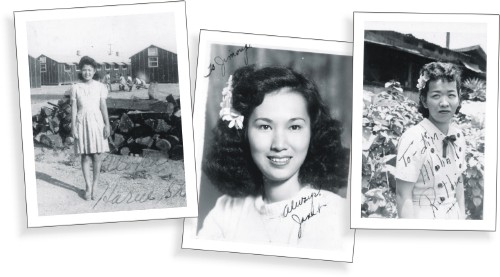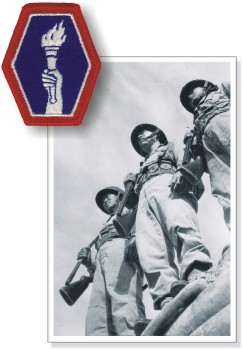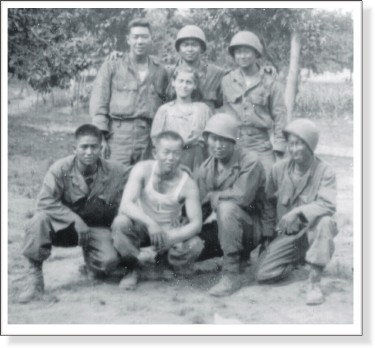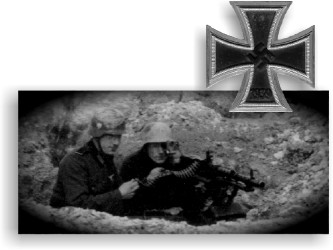![[442ND: Go for Broke]](pix/makino/sub3.jpg)
I was given a pass to leave the Relocation Camp, but only to report directly to the service
at Fort Douglas, Utah. When I was sworn in, there were five of us and we all got separated, but
we all survived the war. From Fort Douglas I went to Camp Shelby, Mississippi for training.
The original symbol for our unit was a steamboat because we had our training there. Later the
symbol was changed to a yellow hand holding a dagger with blood dripping from it. This was
changed because many of the soldiers were offended by the racist overtones of the symbol.
Finally, the "Go for Broke" design was made in 1942 by one of the soldiers from Monterey.
I arrived at Camp Shelby about a month or two after the Hawaii boys and nearly all the non-com
positions were filled. I was one of the few who joined the service after being interned who was
made buck sergeant (three-stripe sergeant) during training. I guess it was because I could get
along with both the Hawaii boys and the mainland boys. I had learned to speak the pidgin English
spoken by the Hawaii boys pretty well from speaking with my sister, Helen's husband George.
George was born in Hawaii and had worked maintaining one of the machines they used at a sugar
plantation before he came to the mainland. Helen and George had been married for several years
by the time the war broke out. At twenty years old, I was also older than most of the mainland
boys and the Hawaii boys were typically from twenty-one to twenty-four years old. At first,
there was a lot of tension between the Hawaii boys and the boys from the mainland, but we soon
learned to get along.
If you went on pass during training, you signed out. Along with signing out, you got a pro-kit (prophylactic kit) which you returned when you came back. Some of the things that came about came about. You'd have to ask some of the guys that went what happened. I didn't do anything. A group of us would go up to an internment camp in Jerome, Arkansas on leave. We were treated very well by the people interned there who would put in for a lavish meal for us. I began corresponding with a beautiful girl at Jerome. After awhile, I realized she was pretty young so after the war, I looked her family up in the records of those who were interned at Jerome. That's when I learned she was only fourteen years old. Oh well, there was no harm, I had only corresponded with her anyway.

Pen-pals (l-r):
Harue Shoda, Jerome Internment Camp; Janet; and Ruthie, Hawaii.
 |
I had several pen-pals I guess. They were girlfriends of my buddies, friends of their friends, and friends of my sisters. It was something to do. Chitchat. It was also a way to keep up on what was going on. Pen-pals were really just that and nothing more. I didn't even meet one of my pen-pals until 1953 when I went on a vacation to Hawaii with my wife.
One day at Camp Shelby, I was called into the Colonel's office. I reported as ordered and gave him a "highball" (salute). He asked me if I thought the troops were ready for battle. I couldn't understand why he was asking me of all people, but I guess he was just trying to find out the morale of the men from amongst them.
Eisenhower didn't want a Japanese-American unit. General Mark Clark of the 34th Nebraska-Iowa, Red Bull Division did. The 100th guys were older than the 442nd because they had all been in the National Guard in Hawaii before the bombing of Pearl Harbor. They took heavy losses at Monte Cassino and were combined with the 442nd. Since both units had an A, B, C, and D company, the 442nd's were broken up into other companies.

Go For Broke:
Worm's Eye View of
Imada, Jones and Tsuha
in Training at Camp Shelby
 |
Cyber Gallery:
"Go for Broke!": A Gallery of the 442nd at Camp Shelby, Mississippi
What is war like? For starters it is quite a shock. You don't really get used to it, but it
doesn't bother you quite as much after a while. We did see a number of Germans, well some were
wounded, but most were dead. It didn't bother me as much as when I saw some of our boys on the
ground. I thought, "Oh my goodness, it could be me." Everyone was scared and afraid. We lived through it.
I go to schools on occasion to teach students about Japanese-American history through the outreach program at the Japanese-American National Museum. We talk about Issei, Nisei, and Sansei (1st, 2nd and 3rd generation Japanese-Americans). Sansei are too busy working to care about history, but Yonsei (4th generation) seem to be interested in their background. At one particular school, a boy kept asking me how many people I killed in the war. He was persistent. All I could tell him was that there is a lot of "bang, bang, bang" and what they call harassing fire. I don't know if I killed anyone. You shoot, but you don't go up and look at the soldier and see if he's dead. You shoot and later advance and see dead soldiers where you were firing. We didn't put a notch somewhere when we shot someone or check to see if they were dead.

Italy(clockwise from top left): Makino, Ihara, Dave Ito,
___ Ito, Bob ___, ___ Matsumoto and Tsugiyasu Toma.
 |
I can't tell you a clean chronology of events that happened when I got to Italy, but I'll
tell you what I remember. First of all, the list of engagements I was involved in was short:
Civitavecchia, Grosseto, Belvedere, Cecina, Pisa, Florence, Pasina, Arno River and Leghorn. At Gila,
each block had 200 people, but you only knew 15 or 20 of your neighbors. In the army, your company consisted of
180-200 men, but you really only knew the 36 or so guys in your platoon. As things happened the group got smaller -
as we contacted enemy. Here are some stories of the guys I fought with or knew about:
George Jones. You'll notice in my pictures at Camp Shelby that there is one fellow who is as white
as anyone. George Jones was a happa (mixed race, half-white and half-Japanese) from New York.
He was from the "free zone", they weren't interning Japanese-Americans back east so I don't know why he
joined up with the rest of us.
"TJ" Fujiwara. There was another happa who fought with us. His name was "TJ" Fujiwara. He was half
Puerto Rican and half Japanese. He was a nice guy, but looked mean. Every platoon had a sniper, and
he was ours. It takes a different kind of guy to be a sniper. When you're pinned down with someone
taking a bead on you (putting their sites on you), you don't want to move so the sniper steps up and
takes the enemy out. One night, we were on patrol. You want it to be quiet when you're on patrol,
but there was a dog who kept barking incessantly. TJ took out his knife and said, "I'll be right
back." The dog wasn't barking when he returned.
Sgt. Nori Sekino. You know, guys in the military use a lot of profanity. There was this one guy
though, Sekino, who never swore. I never even saw this guy get mad. The worst thing that came out of
his mouth was "shucks". That's the kind of guy he was. He was quite a Christian. Everyone in G Company knew
Sekino. He was the platoon sergeant and when he had to give us orders that were passed down from above
through him, there was no quibbling. Everyone knew he wouldn't pick on you. Sekino had his heel severely
injured during the war and received a purple heart.
Okamoto Tomiso. In one battle, I picked one of my men, Okamoto Tomiso, to go flank right. I
was just behind him as we ran forward. There were heavy incoming mortars and one hit him directly.
I was more fortunate. My rifle was torn to pieces so I had to get another, but I was left in one
piece.
Kim. There was a Korean fellow named Kim with the 100th battalion. While he was in the
hospital, he said, "I gotta get outta here because the 442nd is moving on." When he was all better, he
got reassigned, but not with his guys. He was a rifle company officer. While in battle he was making a charge and looked behind him to see nobody was following.
He thought there was a problem and tried again. This sort of thing would never happen with the 442nd.
He told himself, "I gotta get out of here."
Rocky Mariyoshi. Rocky Mariyoshi was the most highly decorated soldier from Company G and he was also
in the third platoon, but in a different squad than mine. His nickname was Rocky because he was built like a rock.
He worked out with barbells all the time. He even had his weights sent to Italy with the kitchen equipment.
He was so concerned about his men he got sick. He ended in the hospital. He left the hospital without being
discharged and went in search of his company. Somewhere along the way, while asking around "Where’s G Company?",
someone told him to "follow the wire." When he came walking up on us he had two captives. He had followed the
telephone wire and ran into a machine gun nest while doing so. He took out two Germans and took the other two
captive, loaded them up with his gear and continued to search for his platoon. He received more medals than
anyone else, but we're still trying to get him the Congressional Medal of Honor.
July 4, 1944. Hill 140 near Civitavecchia.
We were attacking a machine gun nest. I had a
grenade launcher at the end of my rifle and shot it at a German soldier some 20 yards or so in front
of me. He fell down, but there was no explosion from the grenade. In all the excitement, I must have
forgotten to pull the pin from the grenade before I fired it!
Kei Tanahashi. I'd guess that ninety-five percent of our officers were white. Most of the oriental officers were medics.
Well, we were told that we were going to get a Japanese officer. This guy went to OCS (Officer Candidate School) at Fort Benning, Georgia. His name was
Kei Tanahashi. He was my platoon leader. Each platoon had three squads of twelve men. I was the
squad leader of the 2nd squad in the 3rd platoon (a rifle platoon) of Company G. Tanahashi was in
charge of our platoon.
Four of our guys, Tsugiyasu Toma, Bill Nakamura, Kei Tanahashi, and Sgt.
Urabe were killed at Hill 140, scattered left to right by one machine gun. Urabe was on my left. Toma and
Tanahashi were in front of me and Nakamura was on my right. Toma's left arm was torn up real bad.
I put a tourniquet around it with some sulfa drugs. We didn't have painkillers and the medics
only had morphine. Toma was complaining about his back. He had a little hole on his lower back.
He was also complaining about his neck. He had a large hole where his shoulder met his neck. I
think the machine gun fire got his arm first, then spun him around and a bullet enter his back and
exited his shoulder. I didn't see him get his so I don't know, it's just my theory. Tanahashi was
hit in the stomach. I helped take off their shoes and put them on the litters that took them to the
back and never saw either of them again. I have a V-mail that Tanahashi censored and signed June
29th/30th. Just a few days before he was killed.
When we reached the machine gun nest several of our men shot into it and no one came out alive.
We were held up by machine gun fire another time at Hill 140. I was sitting with about five others
feet-to-feet. I had a 536 radio and was yelling for the mortars to fire at the machine gun nest.
We never got any response. This lasted throughout the day and overnight. When the sun began to
rise, I asked for a runner. David Ito ran 400-500 yards up a hill and then turned and signaled for
us to follow. When we reached the top of the hill, we saw the rest of our battalion which had pulled
back through the dark of night!
In one battle, the medic stood up and walked into the fighting with a red cross flag. All the gun
fire stopped and the two medics from both sides treated their guys. That's the way the medics were.
They carried two pouches, scissors and that flag, nothing else to protect them, but they were there
when you called one. The chaplains were the same way, they put their duty before themselves.
[Protestant chaplain, Masao Yamada, from Kealakekua, Hawaii was the first Japanese-American to
become chaplain in the U.S. Army.]
There was this one fellow, "Onion," who lived in San Marino near me, was sent to Gila (59-3-C),
and served in G Company, the same as I did, but I never knew he was in our company until after the
war. Onion got his name because he was called ani san (elder brother). Somehow this was bastardized into "Onion" and the name stuck.
He was a funny, jovial sort of guy who never took things hard, but boy he sure had bad luck. Private
Min Ishida, "Onion", was killed on April 23, 1945, just weeks before the Germans surrendered, by a
partisan's errant shot that found its way to his head.

- German soldiers manning machine gun in France
- Iron Cross, 1st Class
|
Souvenir hunting. We were told not to take items from the enemy because they could be booby-trapped.
Everyone wanted an Iron Cross, but only the German officers had them and they'd run like heck so it was
hard to get one. The P38 was popular too, but it seemed that everyone who got one ended out getting
shot down the road. I know of two or three guys who were shot after they got a hold of one of these guns.
It got so no one wanted one anymore. I got a regular .38 off of a machine-gunner we overran. These guys
were still warm and there was blood all over the gun. Later, I chipped away the blood to clean it up.
I was separated from the gun just like the others before me.
|
It was about 9:00 pm, on July 12, 1944 near Pastina, Italy. There were 60mm and 80mm mortars flying from both sides. 60mm mortars were carried by the infantry. One guy carried a base plate and the tube and another followed behind. The 80mm were carried by support in jeeps. A 60mm mortar could be fired accurately from 200 yards away.
I was hit by enemy mortar fire. I called for a medic. Pulled something from the back of my right leg. Like a pencil in diameter, it was about three inches long, and hot. I pulled it out and threw it away. Then I felt the blood oozing from my wound. I can't remember being in pain. I was more mad than anything else. It wasn't a very bad wound, but I didn't take care of it so it festered and got much worse.

